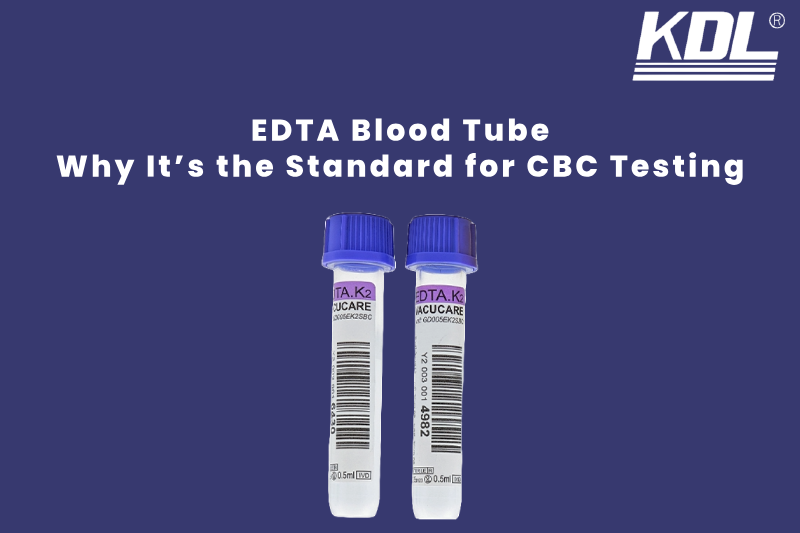
When you go to the doctor and they say, “We need to do a blood test,” they’re probably talking about something called a Complete Blood Count, or CBC. It’s one of the most common tests doctors order, and it tells a lot about your health. But here’s something you may not know: the test depends a lot on the kind of tube the blood is collected in. That’s where the EDTA Blood Tube comes in.
This special purple-top tube has become the gold standard for CBC testing. In this blog post, we’ll explain what it is, why it’s so important in the medical field.
What is an EDTA Blood Tube?
An EDTA blood tube is a small plastic or glass tube used to collect blood for testing. It contains a chemical called EDTA (which stands for Ethylenediaminetetraacetic acid).
Read More About : What Are EDTA Tubes? Uses, Types, Benefits and How They Work
What Does EDTA Do?
EDTA stops blood from clotting by binding with calcium in the blood. Calcium helps your blood form clots, so without it, the blood stays liquid. That’s super important for certain tests like the CBC, where doctors need to count blood cells.
When blood clots, it changes in ways that make it impossible to analyze properly. Clots can trap cells or change their shapes. By keeping blood from clotting, EDTA allows lab machines to measure red blood cells, white blood cells, and platelets accurately.
Why is the EDTA Tube the Standard for CBC Tests?
There are a few reasons EDTA tubes are the top choice for CBC testing:
1. Best for Preserving Blood Cells
EDTA helps keep red blood cells, white blood cells, and platelets in good shape. That means labs get accurate counts and sizes of each type of cell. The shape and size of blood cells are important when diagnosing infections, anemia, and many other conditions. If cells are damaged or clumped together, the results can be misleading.
2. Prevents Clotting Without Changing the Blood
Some other anticoagulants (anti-clotting agents) can change the size or shape of cells. That makes it hard to trust the test results. EDTA doesn’t do that—it keeps the blood as close to its natural state as possible. This is why it’s preferred for detailed cell analysis.
3. Widely Accepted and Trusted
Medical labs all over the world use EDTA tubes for CBC testing. This makes it easier to compare test results from different places. It also means medical supply stores and hospitals always stock purple-top tubes for CBC tests. The consistency and reliability of EDTA tubes make them the industry standard.
4. Works Well with Modern Testing
EDTA tubes are designed to be compatible with the automated machines used in most labs today. These machines quickly count and analyze blood cells. Since EDTA tubes help keep the blood stable, the machines can provide accurate and reliable results without any interference from the sample.
5. Prevents False Results
Some other types of tubes might not stop blood from clotting completely, which could cause some cells to be trapped in clots. EDTA is very good at stopping clotting, which means fewer chances for mistakes in the test results. This is especially important in tests like CBC, where accuracy is key to diagnosing conditions properly.
How Do You Use an EDTA Blood Tube?
Using an EDTA tube is simple for trained professionals. Here’s a quick breakdown:
Step 1: Draw the Blood
A needle is inserted into a vein, usually in the arm, to collect blood. The blood is then directed into the collection tube by vacuum pressure.
Step 2: Fill the Tube to the Mark
Each EDTA tube has a line showing how much blood to collect. Filling it correctly ensures the right ratio of EDTA to blood. Too much or too little can affect the accuracy of the test results.
Step 3: Gently Mix the Tube
After the tube is filled, it needs to be gently turned (not shaken!) about 8 to 10 times. This mixes the blood with the EDTA evenly. Shaking can damage the blood cells and create false results. Mixing helps prevent clots and keeps the blood ready for testing.
Learn more about safe handling techniques for microtubes, especially in pediatric and point-of-care settings.
Other Uses for EDTA Tubes (Besides CBC Tests)
While CBC is the main reason to use an EDTA tube, it’s not the only one.
1. Hemoglobin A1c Testing
This test helps doctors check blood sugar control over time. It’s commonly used for people with diabetes. Because it measures a stable protein in red blood cells, it requires blood that hasn’t clotted—making EDTA tubes perfect for the job.
2. Blood Smears for Microscopy
When doctors want to look at blood under a microscope, EDTA helps keep the cells looking normal. This allows lab techs to spot things like parasites, abnormal cells, or signs of leukemia.
3. DNA and RNA Testing
Some labs use EDTA tubes when collecting blood to look at genes or viruses, like during HIV testing. EDTA helps protect the nucleic acids (DNA and RNA) in the sample.
If you’re working with smaller blood samples, see our guide to capillary blood collection tubes.
Types of EDTA Tubes: Which One Do You Need?
EDTA tubes are not all the same. Different kinds are used for different tests and pieces of devices.
1. K2 EDTA vs. K3 EDTA
- K2 EDTA (dipotassium): Most common and used for automated blood analyzers. It gives more accurate cell volumes.
- K3 EDTA (tripotassium): This is used in some older lab equipment or for tests that are done by hand. Some people think it might make cells swell a little.
2. Glass vs. Plastic Tubes
- Plastic tubes are safer, lighter, and less likely to break. It is use in most hospitals today.
- Glass tubes are more standard, but some labs still use them for certain tasks. Some older machines may need them.
3. Gel-filled EDTA tubes
Some EDTA tubes come with a gel that separates plasma for tests. These is not use for CBC, but they could be pick for genetic studies like testing the load of a virus.
Read More About: microtube types for DNA testing
Common Mistakes to Avoid When Using EDTA Tubes
Even trained staff sometimes make mistakes. Here are a few to watch for:
1. Not Mixing the Tube Properly
If you forget to mix the tube, clots can form. This ruins the sample and leads to inaccurate results.
2. Overfilling or Underfilling
Too much blood can dilute the EDTA. Too little can lead to over-anticoagulation. Both situations affect test accuracy.
3. Using the Wrong Tube
Make sure you’re using a purple-top EDTA tube for CBC—not a red-top or blue-top. Each tube has a different additive for different tests.
Helpful Tips for Clinics and Phlebotomists
If you’re working in a busy clinic or lab, here are a few tips:
1. Use a Blood Collection Tube Rack
This keeps tubes organized and easy to reach. It also avoids mix-ups and contamination.
2. Train Staff on Proper Tube Order
CBC tubes should usually be filled after blood culture and before serum tubes. Follow the correct “order of draw” to prevent cross-contamination of additives.
3. Keep Emergency Supplies On Hand
Always have extra purple-top EDTA tubes in case of lost samples or faulty draws.
Final Thoughts
Little things can make a big difference when it comes to blood tests. The EDTA tube may look like any other piece of plastic, but it is very important for having correct test results. It keeps the blood in good shape, helps doctors make smart choices, and makes sure patients get the care they need.
EDTA tubes are the standard for CBC tests, and that’s not likely to change any time soon. This is true whether you are a nurse, lab tech, clinic manager, or just someone who wants to know more.
 +86-791-8686-1216
+86-791-8686-1216 

